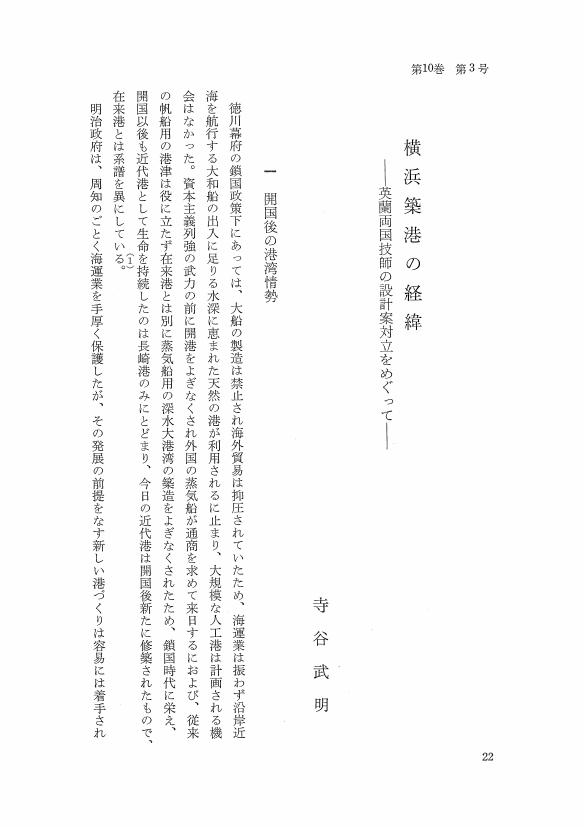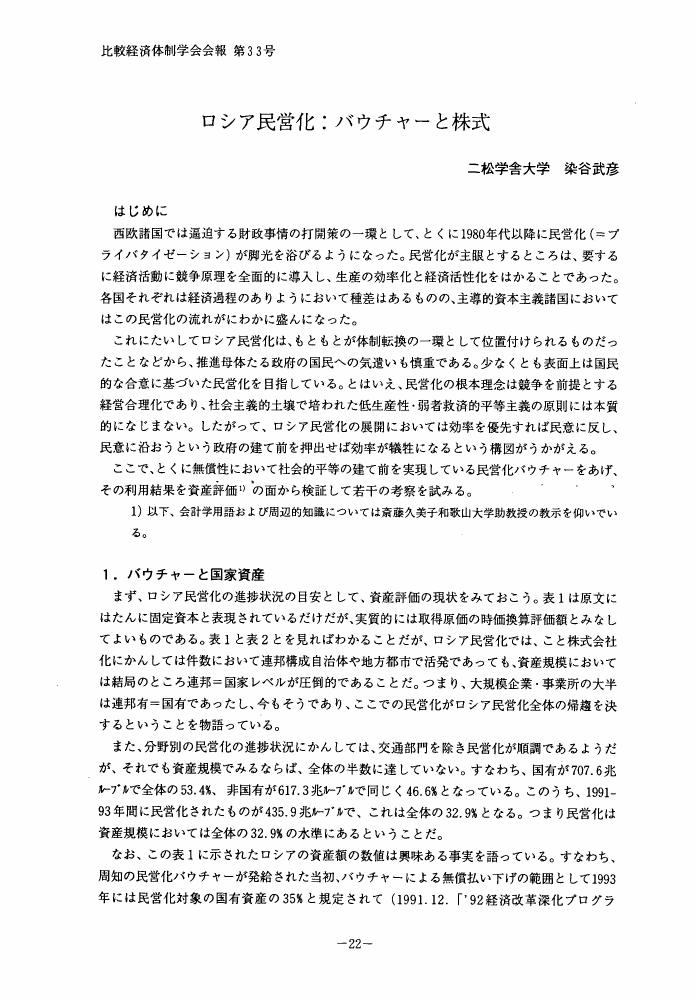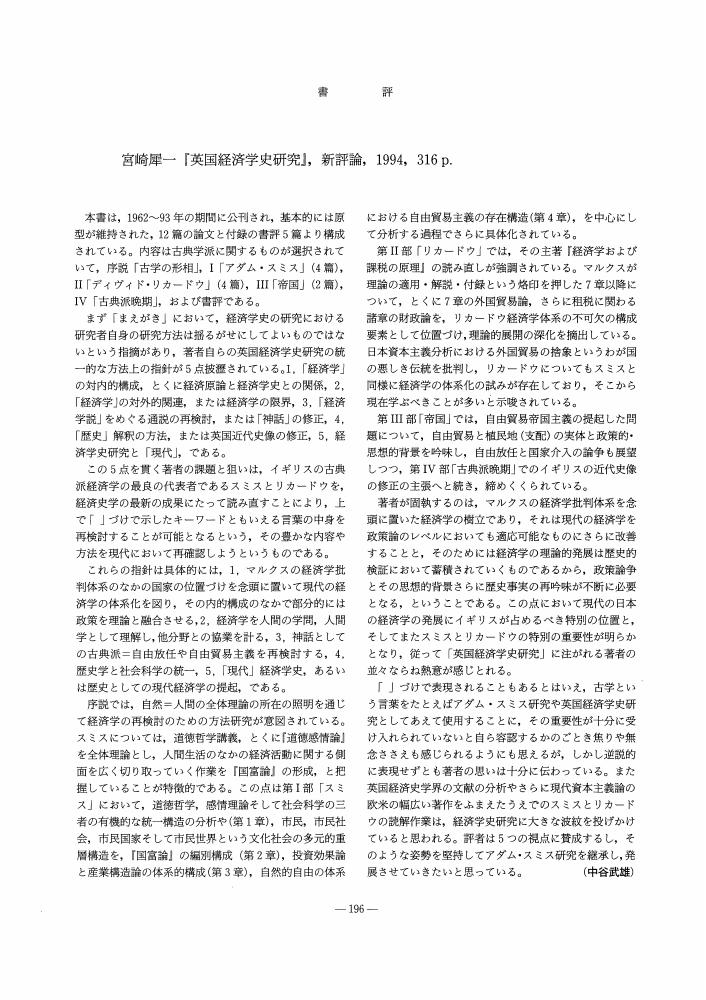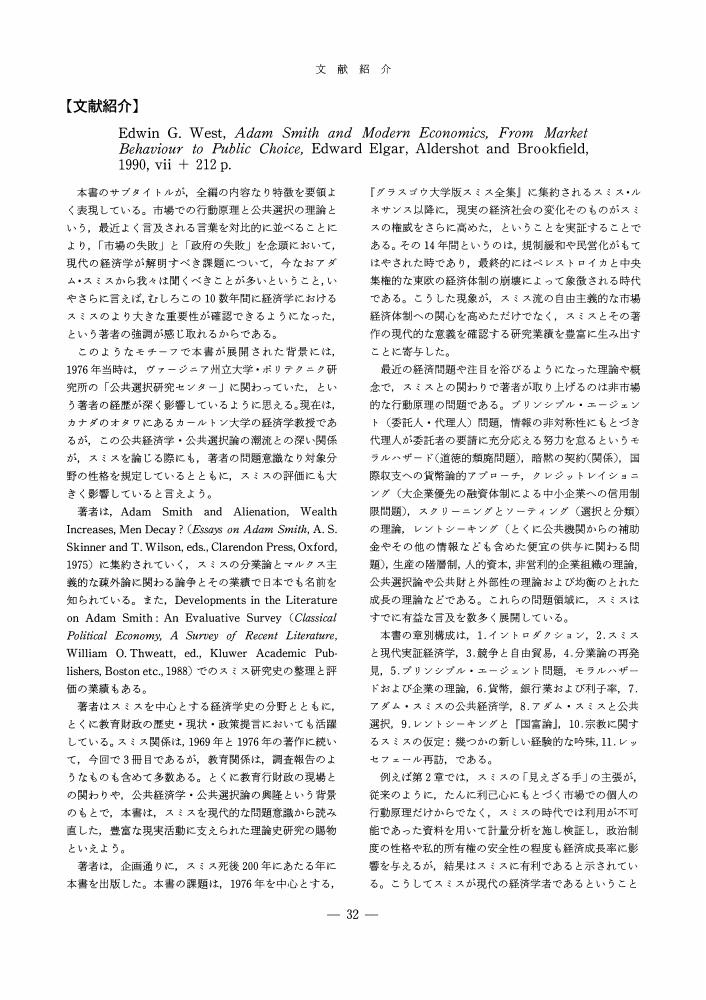1 0 0 0 OA 横浜築港の経緯 英蘭両国技師の設計案対立をめぐって
- 著者
- 寺谷 武明
- 出版者
- 経営史学会
- 雑誌
- 経営史学 (ISSN:03869113)
- 巻号頁・発行日
- vol.10, no.3, pp.22-41, 1975-03-20 (Released:2009-11-06)
1 0 0 0 OA 第一次大戦下における日本造船業の経営転換策 横浜船渠を中心として
- 著者
- 寺谷 武明
- 出版者
- 経営史学会
- 雑誌
- 経営史学 (ISSN:03869113)
- 巻号頁・発行日
- vol.6, no.2, pp.1-24, 1971-11-10 (Released:2009-10-14)
The activities of the Japanese shipbuilding firms in the formative years of the industry were much diversified like “general shops” in engineering just to overcome the difficulties in their main lines. But during world war I the industry was favoured with a great deal of orders from abroad and at home, and most of the firms could be specialized into shipbuilding perse, cutting off the other engineering departments.This paper investigated the case of Yokohama Dock Company, one of the oldest dock yards in Japan. This firm was noted for their early adoption of the form of joint stock company, but they quited the form in spite of its merit, and excluding foreign stockholders, they developed themselves into an independent, specialized shipbuilder.
1 0 0 0 OA 第一次世界大戦下に澄ける日本造舶業の鉄鋼材確保策 -浅野造船所の事例-
- 著者
- 寺谷 武明
- 出版者
- 経営史学会
- 雑誌
- 経営史学 (ISSN:03869113)
- 巻号頁・発行日
- vol.4, no.3, pp.25-53,ii, 1970-07-25 (Released:2010-11-18)
The unprecedented boom of the Japanese shipbuilding industry during World War I was accompanied by a serious difficulty in procuring raw materials. The domestic iron and steel industry had not yet developed enough to supply the local demand. In addition, England and America put into effect an embargo on iron and steel in 1916 and 1917 respectively. The Japanese shipbuilding industry, favored with a great deal of orders from abroad, tried to overcome the shortage of raw materials, first by contracting with the U.S. Government for a supply of iron and steel in return for an equivalent amount of ships, constructed at Japanese shipbuilding yards.But eventually some of the shipbuilding firms, such an Mitsubishi, Kawasaki and Asano, implemented a more long-ranged project for securing raw material; that is, ventures into iron and steel production themselves. In this paper the author has elucidated the procurement policy of Asano Shipyard, established by Soichiro Asano, president of the Toyo Steam-ship Navigation Co.
1 0 0 0 OA 日本造船業成立期における政府と企業 -造船奨励法と石川島造船所-
- 著者
- 寺谷 武明
- 出版者
- 経営史学会
- 雑誌
- 経営史学 (ISSN:03869113)
- 巻号頁・発行日
- vol.2, no.2, pp.85-119,iv, 1967-09-30 (Released:2009-11-11)
Japan's protective policy towards its ship-building industry originated in the enactment of the Ship-Building Promotion Law in 1896. It was intended not to protect particular companies, but to increase the total building capacity of the country by offering premiums for the building of new steel ships larger than 700 tons gross. However, the response to this protective policy and its effects on individual businesses varied markedly depending on the particular circumstances of each ship-yard. This paper attempts to examine the characteristics of the response made by the Ishikawajima Ship-Building Yard to the new law, and the nature of the decisions made by Eiichi Shibusawa, chairman of the company, in the face both of opportunity and crisis.The Ishikawajima company built a large new yard at Uraga in response to the Promotion Law, but it was unable to utilize the yard to its full capacity because of the absence of intimate contacts with major shipping companies, and thus could not take advantage of the premiums offered by the new law. Shibusawa, quick to recognize his mistake, had the foresight to curtail the business, sell the new yard to a competitor, the Uraga Dock Company, established in 1896, and to expand his company's construction of machinery. As a result the company managed to escape total failure, and in a few years had entirely recovered financially. The Uraga Dock Co., meanwhile, was equally unable to take advantage of the huge yard it had bought from Ishikawajima, and its business, too, began to decline gradually.By contrast, both the Mitsubishi and Kawasaki Ship-Building Yard's kept intimate contact with the leading shipping companies, such as Nippon Yusen and Osaka Shosen, and were thus able to secure huge premiums and solidify their positions in the industry.
1 0 0 0 OA ロシア民営化:バウチャーと株式
- 著者
- 染谷 武彦
- 出版者
- 比較経済体制学会
- 雑誌
- 比較経済体制学会会報 (ISSN:18839797)
- 巻号頁・発行日
- vol.1995, no.33, pp.22-25, 1995-11-01 (Released:2009-07-31)
- 著者
- 中谷 武雄 山崎 怜
- 出版者
- 経済学史学会
- 雑誌
- 経済学史学会年報 (ISSN:04534786)
- 巻号頁・発行日
- vol.39, no.39, pp.175-176, 2001 (Released:2010-08-05)
1 0 0 0 OA 宮崎犀一『英国経済学史研究』, 新評論, 1994, 316p.
- 著者
- 中谷 武雄
- 出版者
- 経済学史学会
- 雑誌
- 経済学史学会年報 (ISSN:04534786)
- 巻号頁・発行日
- vol.33, no.33, pp.196, 1995 (Released:2010-08-05)
- 著者
- 中谷 武雄
- 出版者
- The Japanese Society for the History of Economic Thought
- 雑誌
- 経済学史学会年報 (ISSN:04534786)
- 巻号頁・発行日
- vol.29, no.29, pp.32-33, 1991 (Released:2010-08-05)
- 著者
- 白石 貢一郎 喜多岡 健二 石戸谷 武 菅原 幸弥
- 出版者
- 公益社団法人 日本理学療法士協会
- 雑誌
- 理学療法学Supplement Vol.17 Suppl. (第25回日本理学療法士学会誌 第17巻学会特別号)
- 巻号頁・発行日
- pp.261, 1990-03-31 (Released:2017-07-07)
1 0 0 0 OA 大腿骨短縮術
- 著者
- 高岸 直人 田丸 卓郎 大谷 武 山田 元久 武田 守弘
- 出版者
- West-Japanese Society of Orthopedics & Traumatology
- 雑誌
- 整形外科と災害外科 (ISSN:00371033)
- 巻号頁・発行日
- vol.15, no.2, pp.159-160, 1966 (Released:2010-02-25)
1 0 0 0 玄米浸漬時の乳酸菌添加効果
- 著者
- 熊谷 武久 瀬野 公子 渡辺 紀之
- 出版者
- 公益社団法人 日本食品科学工学会
- 雑誌
- 日本食品科学工学会誌 : Nippon shokuhin kagaku kogaku kaishi = Journal of the Japanese Society for Food Science and Technology (ISSN:1341027X)
- 巻号頁・発行日
- vol.53, no.3, pp.179-184, 2006-03-15
- 参考文献数
- 16
- 被引用文献数
- 1 1
乳酸菌添加液に玄米を浸漬することによる乳酸菌の付着性を検討した.<BR>(1)米及び米加工品より分離した<I>L. casei</I> subsp. <I>casei</I> 327を乳酸菌スターターとして,コシヒカリ,ミルキークイーン及びこしいぶきの玄米を用い,玄米浸漬液にスターターを添加して37℃,17時間発酵することにより,乳酸菌の増殖が浸漬液及び玄米で見られた.16SrRNA遺伝子塩基配列により当該菌が増殖したことを確認した.<BR>(2)発酵処理した玄米のpHはおおよそ6であり,炊飯後の米飯の食味に影響を及ぼさなかった.<BR>(3)発酵温度の低下により発酵処理玄米の<I>Lactobacillus</I>数が低下し,玄米と浸漬液の配合比及びスターター量の変化では,大きな影響はなかった.<BR>(4)乳酸菌を添加しない区では,乳酸菌以外の菌数が増加し,<I>Enterobacteriaceae</I>が主要な菌であった.<BR>(5)5菌種,7菌株の乳酸菌,全てで発酵液及び発酵処理玄米の<I>Lactobacillus</I>数の増加が見られ,<I>L. acidophilus</I> JCM1132<SUP>T</SUP>のみ生育が悪く,<I>L. casei</I> subsp. <I>casei</I> 327が最も増殖効果が高かった.
1 0 0 0 当院における両側同時人工膝関節置換術の臨床成績
- 著者
- 藤本 泰毅 西田 康太郎 東 千夏 比嘉 浩太郎 翁長 正道 松田 英敏 石原 昌人 仲宗根 哲 神谷 武志 當銘 保則
- 出版者
- 西日本整形・災害外科学会
- 雑誌
- 整形外科と災害外科 (ISSN:00371033)
- 巻号頁・発行日
- vol.69, no.4, pp.864-866, 2020
<p>両側同時TKAは1回の入院・麻酔,医療コストの削減といった長所がある一方で,手術時間の延長,合併症の報告がある.当科における両側同時TKAの臨床成績を報告する.対象は2011年1月から2018年6月までに両側同時TKAを行った9例(男性4例,女性5例),原疾患は変形性膝関節症4例,関節リウマチ4例,特発性骨壊死1例,手術時年齢は63歳だった.調査項目は,平均手術時間,平均入院日数,術前後のJOA score,大腿骨脛骨角,膝関節ROM,術後の合併症とした.手術時間は平均251分,入院日数は34.6日だった.術前後でJOA scoreは43点が77点に,FTAは184°が177°に,ROMは伸展/屈曲-17°/102°が-2°/108°に改善した.術後の合併症は,表層感染1例,深部静脈血栓症2例,術後貧血1例等6例に認めた.両側同時TKAを安全に行うには年齢や合併症などを考慮しなくてはならない.</p>
- 著者
- 柏口 新二 三嶋 真爾 岡田 知佐子 紙谷 武 高松 晃 石崎 一穂
- 出版者
- 一般社団法人 日本超音波検査学会
- 雑誌
- 超音波検査技術 (ISSN:18814506)
- 巻号頁・発行日
- vol.34, no.4, pp.469-480, 2009-08-01 (Released:2009-08-06)
- 参考文献数
- 16
1 0 0 0 IR スタグフレ-ションについて
- 著者
- 中谷 武
- 出版者
- 神戸大学経済経営学会
- 雑誌
- 国民経済雑誌 (ISSN:03873129)
- 巻号頁・発行日
- vol.142, no.3, pp.p82-102, 1980-09
- 著者
- 伊波 優輝 金谷 文則 東 千夏 山中 理菜 比嘉 浩太郎 松田 英敏 石原 昌人 仲宗根 哲 神谷 武志 當銘 保則
- 出版者
- 西日本整形・災害外科学会
- 雑誌
- 整形外科と災害外科 (ISSN:00371033)
- 巻号頁・発行日
- vol.69, no.2, pp.274-277, 2020
<p>65歳女性.3歳時に右下腿粉砕骨折を受傷(本人申告で詳細不明),12歳までに腓骨・腸骨移植を併用し数回の手術後に骨癒合した.30歳頃にvon Recklinghausen病を指摘され,53歳頃から右足関節の外反変形が増悪し装具や靴を作製したが,症状が増悪したため65歳時に当院へ紹介された.足関節の可動域は背屈/底屈:-10°/45°で,右足関節の外反動揺性が高度であったため,荷重時・歩行時に足関節内側が接地し内果後方に胼胝を形成していた.単純X線像で腓骨遠位が4 cm遺残し,外側遠位脛骨角は67°,踵骨外反は40°だった.CTで距骨下関節の関節裂隙は保たれていた.手術は全身麻酔下に外側アプローチで切除した腓骨遠位を骨移植し,距腿関節固定術を行った.術後4週免荷,その後は装具装着下に部分荷重を開始し,術後8週で全荷重を許可した.術後1年,疼痛は軽快し市販の靴を履いて独歩可能である.</p>
1 0 0 0 OA 置塩『蓄積論』再考(<特集>置塩経済学の可能性)
- 著者
- 中谷 武
- 出版者
- 経済理論学会
- 雑誌
- 季刊経済理論 (ISSN:18825184)
- 巻号頁・発行日
- vol.50, no.4, pp.5-15, 2014-01-20 (Released:2017-04-25)
置塩信雄『蓄積論』(初版)は1967年に出版された。その後,世界や日本の経済が成長率の低下やさまざまな危機を経験する中で,経済理論自体も大きく変貌してきたが,現在の近代経済学(主流派経済学)の基本的な枠組みは変わっていない。これに対するマルクス経済学やポストケインズ派経済学などの批判的経済学にも新しい動きが出てきている。本稿は,置塩『蓄積論』の基本的メッセージを,(1)資本制の歴史性,(2)不均衡とその累積性,(3)利潤と投資の主導性,(4)資本制の長期法則の4点から整理し,現時点でその重要性を評価する。次に,批判的経済理論の一つとして最近多くの研究が行われているカレツキ等のポストケインズ派を対象に,その貢献と問題点を論じる。
1 0 0 0 OA ガスクロマトグラフィーによる豆類中のシアン化合物の定量
- 著者
- 近本 武次 米谷 武士
- 出版者
- Japanese Society for Food Hygiene and Safety
- 雑誌
- 食品衛生学雑誌 (ISSN:00156426)
- 巻号頁・発行日
- vol.25, no.6, pp.530-533_1, 1984-12-05 (Released:2009-12-11)
- 参考文献数
- 8
- 被引用文献数
- 3 4
豆類に含まれるシアン化合物をFID-ガスクロマトグラフィー (GC) により簡便に定量する方法を確立した. 酵素分解により青酸配糖体から遊離したシアン化水素を水蒸気蒸留し, アルカリ性溶液中に捕集した. 蒸留液の一定量をとり減圧濃縮した後, 1Mギ酸を加えて酸性とし, この溶液をFID-GCに供しシアン化水素の定量を行った. 豆類に由来する揮発性有機化合物の妨害を受けることなく, 2μg/g以上のシアン化合物 (シアン化水素として) を検出することが可能であった. 本法による定量値は, 吸光光度法 (ピリジン-ピラゾロン法) による定量値とよく一致した.
1 0 0 0 高密度高均一量子ドットを用いた量子ドットレーザ
- 著者
- 天野 建 菅谷 武芳 小森 和弘
- 出版者
- 一般社団法人電子情報通信学会
- 雑誌
- 電子情報通信学会技術研究報告. LQE, レーザ・量子エレクトロニクス (ISSN:09135685)
- 巻号頁・発行日
- vol.105, no.455, pp.45-48, 2005-12-09
- 参考文献数
- 12
我々は高密度な量子ドットを用いた量子ドットレーザの研究を行っている。As_2分子線と組成傾斜歪み緩和層を用いることで, 量子ドット密度の1.0×10^<11>cm^<-2>を超える高密度化を実現した。また, 併せてPL半値幅22meVの均一化も実現した。さらに高密度化と高均一化が実現した量子ドットからPL測定により基底準位の発光強度増強も確認できた。この高密度かつ高均一な量子ドットを用いた半導体レーザを製作し, 高反射膜ミラー構造無しでもレーザ発振を実現した。また, 一層当たり8cm^<-1>を超える大きなモード利得を得たので報告する。この結果は量子ドットを高密度かつ高均一にしたためであり, 通信用量子ドットレーザの実用化に向けて大きな成果と考えている。
- 著者
- 松前 ひろみ 長谷 武志 清水 健太郎
- 雑誌
- 研究報告人文科学とコンピュータ(CH) (ISSN:21888957)
- 巻号頁・発行日
- vol.2020-CH-122, no.2, pp.1-5, 2020-01-25
ヒトのゲノム情報からは,人類の系統や混血などの歴史を詳細かつ統計的に推定することができる.そうしてゲノムから推定される民族集団史の系統関係と,文化,とりわけ言語の分類には,一定の関連があると考えられてきた.しかし言語の分類のうち,言語族という語彙レベルで近縁な言語間の関係を除くと,遠い言語同士の関係(例えば日本語,アイヌ語,韓国語)を定量的に分析することは,これまで困難であった.私たちは文法の比較法である言語類型論の研究者とともに,文法のデータベースから定量的に語族を超えた言語の特徴の類似性を抽出し,ゲノムに基づく民族集団の関係との関係性を分析することに成功した.データベースに蓄積された文化と生物学の情報を統合的に解析する方法を提案する.
1 0 0 0 櫛田ふきさん 長い間、ありがとうございました
- 著者
- 守谷 武子
- 出版者
- 日本共産党中央委員会 ; 1979-
- 雑誌
- 女性のひろば (ISSN:03879429)
- 巻号頁・発行日
- no.266, pp.104-107, 2001-04







